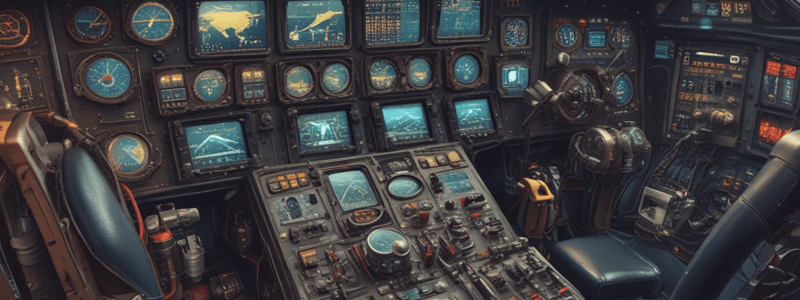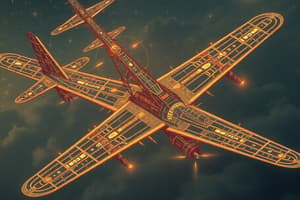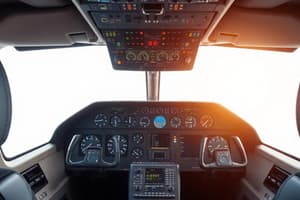Podcast
Questions and Answers
What is the purpose of the roll augmentation function in an aircraft?
What is the purpose of the roll augmentation function in an aircraft?
To reduce any roll rate not commanded by the pilot.
What happens to the roll augmentation feature in the event of a spoiler panel malfunction?
What happens to the roll augmentation feature in the event of a spoiler panel malfunction?
It deactivates after five seconds and remains off for the duration of the flight.
How do roll spoiler deflections vary with flap position and airspeed?
How do roll spoiler deflections vary with flap position and airspeed?
The amount of roll spoiler deflection varies, with higher flap positions and airspeeds resulting in smaller spoiler deflections.
What is the role of the yaw damper in flight control systems?
What is the role of the yaw damper in flight control systems?
In the long term, what happens to any persistent elevator offset greater than one degree in pitch trim?
In the long term, what happens to any persistent elevator offset greater than one degree in pitch trim?
What are the main components of a pillow block assembly in the flap system?
What are the main components of a pillow block assembly in the flap system?
What are the three basic functions performed by the flap actuators?
What are the three basic functions performed by the flap actuators?
Explain the purpose of the force-limiting function in each flap actuator.
Explain the purpose of the force-limiting function in each flap actuator.
How does the fly-by-wire technology in the flight control system ensure irreversibility of the flap actuators?
How does the fly-by-wire technology in the flight control system ensure irreversibility of the flap actuators?
Explain the purpose of the artificial feel mechanisms in the horizontal stabilizer system.
Explain the purpose of the artificial feel mechanisms in the horizontal stabilizer system.
Explain the purpose of the bungee rods in the flight control system.
Explain the purpose of the bungee rods in the flight control system.
Describe the backup system for the flight control surfaces in the event that both Flight Control Computers (FCCs) are inoperative.
Describe the backup system for the flight control surfaces in the event that both Flight Control Computers (FCCs) are inoperative.
Explain the purpose of the mechanical stops in the flight control system.
Explain the purpose of the mechanical stops in the flight control system.
How are the pilot and copilot rudder pedals connected, and what is the purpose of this connection?
How are the pilot and copilot rudder pedals connected, and what is the purpose of this connection?
Describe the role of the trim switches in the flight control system.
Describe the role of the trim switches in the flight control system.
What is the purpose of the hydraulic system in aircraft flight control surfaces?
What is the purpose of the hydraulic system in aircraft flight control surfaces?
What is the role of the Regulating and Shutoff Unit (REU) in the aircraft hydraulic system?
What is the role of the Regulating and Shutoff Unit (REU) in the aircraft hydraulic system?
Describe the 'damped bypass' mode of operation for an aircraft actuator.
Describe the 'damped bypass' mode of operation for an aircraft actuator.
What is the purpose of the Electrical Backup Hydraulic Actuator (EBHA) in an aircraft's flight control system?
What is the purpose of the Electrical Backup Hydraulic Actuator (EBHA) in an aircraft's flight control system?
How do pilots experience the behavior of damped bypass actuators during ground operations?
How do pilots experience the behavior of damped bypass actuators during ground operations?
Flashcards are hidden until you start studying
Study Notes
Roll Augmentation
- The roll augmentation function adjusts roll control surface deflections based on the magnitude of roll rate compared to the expected roll rate from wheel and pedal inputs.
- It reduces uncommanded roll rates caused by wake turbulence or spoiler panel malfunction.
- In the event of a spoiler panel malfunction, the roll augmentation feature will deactivate after 5 seconds and remain inactive for the duration of the flight.
Roll Spoiler Deflection
- The amount of roll spoiler deflection varies with flap position and air speed.
- Deflection can be as much as full deflection (55°).
- Outboard and midboard roll spoilers are commanded to move together.
Yaw Control
- The yaw damper is active using sensor feedback and rudder pedal input to damp dutch roll oscillations.
Pitch Trim
- Pitch trim initially offsets the elevator.
- Persistent elevator offset greater than 1 degree will be offloaded to the horizontal stabilizer.
Pillow Block Bearings
- Each pillow block consists of two ball bearings, an aluminum housing, and an externally-splined through-shaft.
- The bearings are sealed to prevent FOD and moisture ingress and are packed with grease.
Flap Actuators
- Each flap surface is driven by two linear ballscrew flap actuators.
- The actuators are lubricated with grease and vented to prevent corrosion.
- The actuators perform three functions: conversion of high-speed rotary motion, irreversibility, and system overload protection.
Flap Position Sensors
- The sensors have springs and dampers to provide appropriate "feel" forces and mechanical stops to limit their maximum displacement.
Flight Control System (FCS)
- The system consists of two dual-channel Flight Control Computers (FCCs) and a Backup Flight Control Unit (BFCU).
- The FCCs generate commands for the control surface actuators and house the operational logic (Control Laws) for control of the flight control surfaces.
- Any one of the four FCC channels is independently fully capable of safely operating the entire aircraft FCS.
###.backup Flight Control Unit (BFCU)
- The BFCU controls the elevators, ailerons, outboard spoilers (roll control only), and rudder in the event that both FCCs are inoperative.
- The aircraft may be dispatched with one FCC channel inoperative or the BFCU inoperative with restrictions.
Hydraulic System
- The system provides pressurized fluid to position the flight control surfaces.
- Hydraulic pressure must be available and the actuator REU must electrically hold a solenoid.
- The REU can force Damped Bypass operation by removing power from the solenoid.
Damped Bypass
- The actuator is in a passive condition that resists movement proportional to the rate at which the surface is moved.
- Hydraulic fluid is trapped within the actuator to prevent control surface flutter in flight and provides gust protection during ground operation.
Electric Backup Hydraulic Actuator (EBHA)
- The EBHA has three modes of operation: Hydraulically Active, Electric Backup, and Damped Bypass.
- In the event that a surface cannot be powered by an engine-driven hydraulic source, an Electrical Backup hydraulic pump will provide the EBHA actuator with hydraulic pressure to operate the flight control surface.
Studying That Suits You
Use AI to generate personalized quizzes and flashcards to suit your learning preferences.



